Wingsong: Restricting Sound Access to Spotted Owl Recordings

I am not a board games person, yet I always seem to find myself surrounded by them. Such was the case one August evening in 2023, during a round of the bird-watching-inspired game, Wingspan. Released in 2019 by Stonemaier Games, designer Elizabeth Hargrave’s creation is credited with a dramatic shift in the board game industry. The game received an unparalleled number of awards, including the prestigious 2019 Kennerspiel des Jahres (Connoisseur Game of the Year), and an unheard of seven categories of the Golden Geek Awards, including Best Board Game of the Year and Best Family Board Game of the Year. In addition to causing shifts in typical board game topic, artistry, and demographic, Wingspan has led many board game fans to engage with the natural world in new ways, even inspiring many to become avid birders.
Following the game’s rise to popularity, developer Marcus Nerger released an app, Wingsong which allows players to scan each of the beautifully illustrated cards and play a recording of the associated bird’s song. On the evening in question, the unexpected occurred when I scanned the Spotted Owl (Strix occidentalis) card and received a message that read:
Playback of this birds[sic] song is restricted.
Of course, I had to know more. Although the board game was originally designed using information from the Cornell Lab of Ornithology’s eBird.org website, Wingsong derives its recordings from another free database, xeno-canto.org. A quick search of the website revealed the following statement:
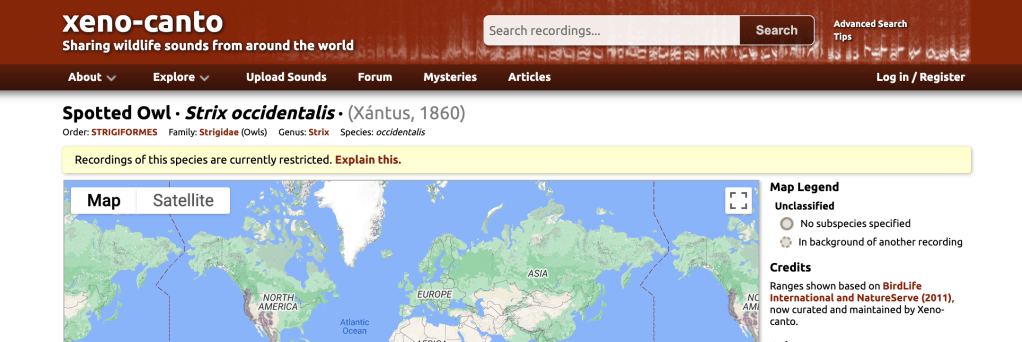
Some species are under extreme pressure due to trapping or harassment. The open availability of high-quality recordings of these species can make the problems even worse. For this reason, streaming and downloading of these recordings is disabled. Recordists are still free to share them on xeno-canto, but they will have to approve access to these recordings.
Though Xeno-Canto does not give specific details about each recording, the Wingspan card offers a clue in italics at the bottom: “Habitat for these birds was a topic in logging fights in the Pacific Northwest region of the US.”
The unexpected incursion of such politics into a board game is startling, especially given the limited information in the initial message. As such, the restriction of Spotted Owl recordings on Xeno Canto, and by extension Wingsong, suggests complicated issues relating to the ownership and distribution of sound, censorship, and conservation.
Spotted Owl Recordings
The status of the Spotted Owl was a major issue of public debate in Oregon of the 1980s and 90s, where I grew up. As Dr. Rocky Gutiérrez, the “godfather” of Spotted Owl research, wrote in an article for The Journal of Raptor Research, “Conservation conflicts are always between people – not between people and animals” (2020, 338). In this case, concerns about the impacts of logging in old-growth forests, thought to be the primary habitat of the Spotted Owl, pitted loggers and the timber industry against conservationists. On both sides, national entities like the Sierra Club and the Western Timber Association helped turn a regional management issue into one with implications for forest protection, wildlife conservation, and economic development across the nation. Forty years later, it is still a hot button issue for scientists, industry, and the government, now with added complications of fire control, climate change, and competing species like the Barred Owl (Strix varia).
Xeno-Canto uses a Creative Commons license, meaning that users can access and apply to a wide variety of projects without explicit permission of the recordist, but it also offers tools for contacting other users. I wrote to two recordists who uploaded Spotted Owl calls to Xeno Canto: Lance Benner and Richard Webster, both recording in southern areas where the Spotted Owl’s conservation status is slightly less dire than in Oregon. Benner is a scientist at the NASA Jet Propulsion Laboratory at the California Institute of Technology, whose recordings have been used in scientific research projects, at nature centers, in phone apps, and notably, in a Canadian TV show. Benner told me via email that he agrees with Xeno-Canto’s restriction on the Spotted Owl recordings to the public, writing
I used to play spotted owl recordings when leading owl trips but I don’t any more now that the birds have been classified as “sensitive.” There have also been multiple attempts to add the California Spotted Owls to the endangered species list, so if I find them, I’m not sharing the information the way I used to….
Webster, on the other hand, offered a slightly different perspective:
There are enough recordings in the public domain that restricting XC’s recordings probably will not make a difference. However, some populations of Spotted Owl are threatened, and abuse is quite possible…
As Webster points out, numerous recordings of Spotted Owls are readily available, including via The Cornell Lab of Ornitology’s Voices of North American Owls and other audio field guides. The concern with such recordings, Gutiérrez told me over Zoom, is that anti-Spotted Owl activists might use the recordings to “call in” Spotted Owls – essentially a form of audio catfishing historically used in activities like duck hunting. In the case of Spotted Owls, the concern is that activists might deliberately harm the birds. However, it can also be a dangerous practice when used by birders who simply want to get a closer look: birds may abandon their nests, leaving chicks vulnerable and unprotected.
From a sound studies perspective, “calling in” underscores questions of avian personhood. Rachel Mundy contends that audio field guides are structured by people in ways that highlight animal musicianship. Yet when we consider the practice of “calling in,” it becomes clear that birdsong recordings are not only designed for human ears, but also avian ones.

Nonetheless, while birds are considered intelligent enough to recognize a call from their own species, they are not believed to be able to identify the difference between a recording and a live performance. The bird’s sensorium is short-circuited by the audio recording, tricking it into thinking a mate is nearby. Not only does this recall the interspecies history of the RCA Victor label His Master’s Voice, it highlights distinctly human anxieties about the role of recording and its ability to dissimulate. Restricting access to such recordings, then, revives deep-seated ethical questions that require a nuanced application.
Whether or not Spotted Owls are able to differentiate between a recorded call or the call of a live mate it is likely to be of decreasing concern, however: Gutiérrez suggests that Northern Spotted Owl populations are so small that anyone attempting to call one in would be unlikely to actually find one.
Immersion, Conservation, Reflection
App developer Marcus Nerger conceptualizes Wingsong as part of an immersive augmented reality experience, one that situates the game player in a more realistic soundworld. In the world of board games, parallels might be drawn to audio playlists used in tabletop role playing games like Dungeons and Dragons, or to the immersive soundscape design used in video games.
Via Zoom, Nerger and I discussed the importance of sound in bird identification, which is arguably more significant than vision given birds’ general fearfulness of humans, branch cover, and the physical distance bird and observer – a separation underscored by the pervasive use of technologies like binoculars. Wingsong is not simply immersive because it connects the player to the real bird species, but because the experience of birding relies as much on hearing as it does on sight.
However, the Spotted Owl restriction message provides a provocative interruption to the immersive bird song experience provided by Wingsong. It is a jarring contrast to the benign experience of listening to recorded bird song, reminding the player of both the artifice of game play and the consequences of environmental actions. It suggests that the birds in the game are not hyper realistic Pokémon to be simply collected, but rather living animals embedded in environmental and political histories. The lack of information provided in the “restricted” message leaves the player wanting more – and subsequently, with a bit of searching, unearthing the mechanics behind the app, the politics of bird song recording, and finally, the specific histories of the species contained there, the ghost in the machine irrevocably unveiled.
—
Featured Image: by author
—
Julianne Graper (she/her) is an Assistant Professor in Ethnomusicology at Indiana University Bloomington. Her work focuses on human-animal relationality through sound in Austin, TX and elsewhere. Graper’s writing can be found in Sound Studies; MUSICultures; forthcoming in The European Journal of American Studies and in the edited collections Sounds, Ecologies, Musics (2023); Behind the Mask: Vernacular Culture in the Time of COVID (2023); and Songs of Social Protest (2018). Her translation of Alejandro Vera’s The Sweet Penance of Music (2020) received the Robert M. Stevenson award from the American Musicological Society.
—

REWIND! . . .If you liked this post, you may also dig:
Animal Renderings: The Library of Natural Sounds — Jonathan Skinner
Sounding Out! Podcast #34: Sonia Li’s “Whale” — Sonia Li
Catastrophic Listening—China Blue
Learning to Listen Beyond Our Ears: Reflecting Upon World Listening Day–Owen Marshall
Botanical Rhythms: A Field Guide to Plant Music–Carlo Petrão
The Better to Hear You With, My Dear: Size and the Acoustic World--Seth Horovitz
The Screech Within Speech–-Dominic Pettman
From Spanish to English to Spanish: How Shakira’s VMA Performance Showcases the New Moment in Latin Music “Crossover”

***This post is co-written by Petra Rivera-Rideau and Vanessa Díaz
On the night of September 12, Colombian pop star Shakira made history as the first predominantly Spanish-language artist to be honored as MTV’s Video Vanguard at the Video Music Awards (VMAs). The award recognizes artists who have had a major and innovative impact on music videos and popular music. Shakira played a 10-minute medley of Spanish and English hits from her three-decades long career. Her performance demonstrated her breadth as an artist as she shifted from pop to rock to reggaetón.
Not only did she demonstrate her impressive musical range, but of her 69 singles, Shakira selected those that represent two significant crossover moments for Latin music. She sang hits like “Wherever, Whenever,” “Hips Don’t Lie,” and “She Wolf” from her English-language crossover in the early 2000s as part of the so-called “Latin Boom.” She sang 2001’s “Objection (Tango)” with the same samba/rock music arrangement she used at her very first VMA performance in 2002.
During this “Latin Boom” of the late 1990s and early 2000s, Shakira and other established Latin stars who had previously performed in Spanish, such as Ricky Martin, Marc Anthony, and the late Selena Quintanilla, dominated the charts with English-language albums. Despite their successful global careers in the Latin market—and the long history and influence of Latinx musicians in U.S. pop music–U.S. media consistently portrayed these artists as exotic newcomers to the scene, praised more for being “Latin lovers” than established musicians. The Latin boom stars were valued as spicy foreigners there to expose Americans to new, exotic Latin sounds – conga beats, flamenco-style guitar riffs, and festive horns – even as many of these songs draw from familiar rock/pop references. Draco Rosa, one Ricky Martin’s co-writers, remembers “channeling [Jim] Morrison” and “elements of big band … a little bit of surf guitar” in the 1999 smash “Livin’ La Vida Loca.”

Despite the Latin Boom’s English-language crossovers, the images and sounds associated with the moment underscored the artists’ foreignness, something that continues today. This year’s Grammys’ botched treatment of superstar Bad Bunny’s performance and acceptance speech, in which, in lieu of translations, the subtitles merely declared that his words were “non-English.” Spanish has long been used to signify Latinxs’ alleged foreignness and inability to assimilate into US life and culture despite the fact that Latinx communities have been part of the fabric of the US for centuries. In the context of increased anti-immigrant sentiment, the popularity of Spanish-speaking artists like Bad Bunny and Shakira takes on even greater significance.
Following the Grammy’s disastrous handling of Bad Bunny’s performance and speech, backlash ensued. A plethora of popular memes and even t-shirts proudly claiming non-English popped up almost overnight. New York Times’ critic and Princeton professor Yarimar Bonilla proclaimed that “Bad Bunny is [Winning in Non-English].” Celebrities from comedian Cristela Alonzo to rapper 50 Cent admonished CBS. Even California Congressman Robert Garcia sent a letter directly to the CBS president and CEO George Cheeks, writing that the incident “display[ed] a lack of sensitivity and foresight. For too many Spanish-speaking Americans, it felt disrespectful of our place in our shared society, and of our contributions to our shared culture.” CBS eventually released a tepid statement saying that their vendor was not adequately equipped to manage Benito’s Spanish-language speech and performance, and Cheeks took “full responsibility” for the incident. Overall, the Grammys snafu reflects the ways in which the American mainstream still is incapable of embracing the status of Latin artists as equal players in the US and global music markets, in any language.
Compared to this year’s Grammys, however, MTV’s VMAs offered a much more inclusive approach, with a historic perspective that demonstrated exactly how we were able to arrive at this new moment in Latin music. When Puerto Rican and Cuban American rapper Fat Joe and Mexican pop star Thalia presented the award for Best Latin video, Thalia reminded the audience that “in the 2000s’ first Latin explosion, we had a song together, and now we’re here celebrating again this new Latin explosion.” This new Latin explosion refers to the numerous Spanish-language artists like Shakira, Bad Bunny, Karol G, and Peso Pluma who have recently broken out in the US mainstream.
But, unlike the previous Latin Boom, these artists have maintained their Spanish and their musical style. Bad Bunny’s Grammy performance included plena, reggaeton, and merengue rather than the kitschy styles of his Latin Boom predecessors. In addition to selling out stadiums around the country, Karol G drew 15,000 fans, the largest crowd in the Today Show’s history, for her reggaetón performance as part of the program’s Summer Concert Series in Rockefeller Center. Just this past September, Eslabon Armado became the first Mexican regional music group to ever perform on Good Morning America with their chart-topping hit “Ella Baila Sola” (the first Mexican regional song to ever hit number one on Billboard’s Global 200 chart). Whether it is the percussive dembow beat of reggaetón or the syncopated horns of corridos tumbados, all of these musicians have maintained the sounds of their respective genres, foregoing the stereotypical “Latin” sonic signifiers historically associated with Latin music.
Shakira herself reflected this moment in her Video Vanguard performance. She performed her new Spanish-language songs as 2022’s “Te Felicito,” and 2023’s “TQG” and “Bzrp Music Sessions: Volume 53” (the latter having broken four Guinness world records, including the most streamed Latin track in 24 hours). All of these songs have been part of this new Latin music movement. In fact, her “TQG” collaborator Karol G also performed her Spanish hits at the show. Mexican regional phenom Peso Pluma sang “Lady Gaga” on a small stage, surrounded only by his band, and called out “¡arriba México!” at the end. Brazilian artist Anitta performed a multilingual medley from her Funk Generation: A Favela Love Story. In addition, Shakira and Karol G won the award for best collaboration for “TQG.” Not only did the women give their acceptance speech in Spanish, shouting out their home country of Colombia, but they also won in a category otherwise populated by mainstream English-language artists like Doja Cat with Post Malone, and Metro Boomin with The Weeknd, 21 Savage, and Diddy. The interchangeable, tropical Latinidad of the earlier Latin boom was replaced with shout outs to specific countries and regions, and the crowd proudly waved Mexican, Puerto Rican, and Colombian flags. At the VMAs, Latin musicians were not isolated in Latin awards categories or depicted as exotic novelties. They were central to the show – nominated for major awards, and celebrated for some of the night’s most memorable performances.
Much like this year’s Coachella, which featured Bad Bunny and K-Pop sensation Black Pink as headliners, this year’s VMAs reflects a more global approach to pop music. Tuesday night’s award show also featured two performances by K-Pop groups, and MTV offered its first ever award in Best Afrobeats. In this context, it makes sense that Latin music would have a significant presence in the program. But the dominance of Latin music right now makes it so that no part of the music industry can leave Latin music out anymore. Not the VMAs, not the Grammys, not Coachella. As Thalia proudly declared on stage, “this last year for the first time in the US Latin music made a billion dollars in streaming.” Bad Bunny has been the most streamed artist on Spotify for three years in a row, has the longest-running Spanish-language album at the top of the Billboard chart, and in 2022 became the only artist in history to stage two separate $100 million-grossing tours in less than 12 months. Karol G became the first woman to have a Spanish-language debut at number one, and came to the VMAs after a string of historic performances at her Mañana Será Bonito stadium tour. Latin music’s global appeal is undeniable and the industry has to respond accordingly.
This is among the most important times in history for Latin music, and honoring artists like Shakira center stage at the VMAs helps underscore the musical evolution we are lucky enough to witness. Twenty years ago, Shakira had to crossover into the US market in English; now she performs in her native Spanish and is more relevant than ever. The global success of stars like Peso Pluma, Karol G, and Bad Bunny means we need to completely reevaluate the concept of the crossover. Latin artists today did not crossover, the market crossed over into them. They are not compromising their language, their identity, or their culture. They do not have to kowtow to industry expectations that they perform the exotic, sexy Latin other. So while the VMA Vanguard Award winner Shakira may have had to crossover into English to make it during the ‘90s Latin boom, she can proudly return to her roots and, this time, the market will follow her.
—
Featured Image: Screen shot by SO! from Shakira’s MTV 2023 Video Vanguard acceptance speech
—
Petra Rivera-Rideau is Associate Professor of American Studies at Wellesley College, and the author of Remixing Reggaetón: The Cultural Politics of Race in Puerto Rico and the forthcoming book Fun, Fitness, Fiesta: Selling Latinx Culture in Zumba Fitness. Vanessa Díaz is Associate Professor of Chicana/o and Latina/o Studies at Loyola Marymount University, and the author of Manufacturing Celebrity: Latino Paparazzi and Women Reporters in Hollywood. Díaz and Rivera-Rideau are the co-creators of the Bad Bunny Syllabus.
—

REWIND!…If you liked this post, you may also dig:
Ronca Realness: Voices that Sound the Sucia Body—Cloe Gentile Reyes
Contra La Pared: Reggaetón and Dissonance in Naarm, Melbourne—Lucreccia Quintanilla
Unapologetic Paisa Chingona-ness: Listening to Fans’ Sonic Identities–Yessica Garcia Hernandez
SO! Podcast #74: Bonus Track for Spanish Rap & Sound Studies Forum
Listening (Loudly) to Spanish-Language Radio– D. Inés Casillas






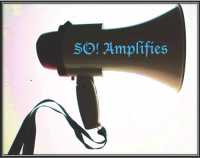
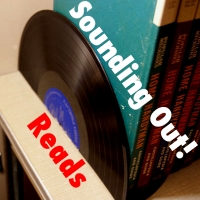

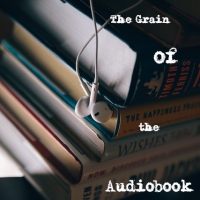
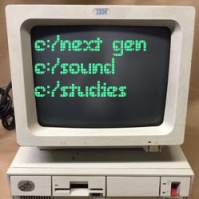




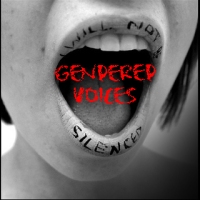
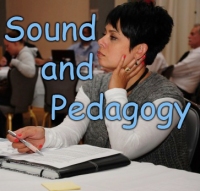

Recent Comments